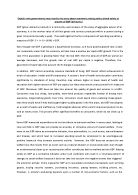The Gross Domestic Product of a country brings many benefits to a quantifiable account of a country’s economic abilities, taking the equation set out earlier in this essay, the components of the equation: C (consumption) tells us about the private (household final consumption expenditure) in the economy. These personal expenditures fall under one of the following categories: durable goods, non-durable goods, and services. I (investment) include business investment in equipments for example and do not include exchanges of existing assets. G (government spending) is the sum of government expenditure on final goods and services; it includes salaries of public servants, purchase of weapons for the military, and any investment expenditure by a government. X (exports) represents gross exports, the GDP captures the amount that a country produces, which includes goods and services produced for other nations’ consumption, therefore export and added. The M (imports) represents gross imports. FCE can be further broken down by three sectors (households, governments and non-profit institutions). So the GDP tells us about the market value of the goods and services produced by a country, by summing up all the expenditure.
GDP is criticized for its inability to measure the standard of living in an economy, however it us often used as such an indicator, on the rationale that all citizens would benefit from their country’s increased economic production. Similarly, GDP per capita is not a measurement of personal income. GDP may increase while real incomes for the majority decline. For example, in the U.S from 1990 to 2006, the earnings (adjusted for inflation) of individual workers, in private industry and services, increased by less than 0.5% per year while GDP (adjusted for inflation) increased about 3.6% per year. The major disadvantage of GDP per capita is that it does not measure standard of living, the GDP is intended to be a measurement of total national economic activity, which is a separate concept from the standard of living, which it lacks.
There are limitations to GDP; it does not take disparity in incomes between the rich and the poor into account.
Underground economy, where the GDP does not take account for also leads to the GDP being underestimated, these transactions contributing to production. Taxation, corruption, excessive regulations and the efficiency of the government are among the causes of the underground economy, these take place outside the official economy, such activities are unrecorded by the system of national income accounting.
The non-monetary economy is a critical part of a healthy community economy, examples such as household labor and civic activities, if these components were reasonably valued in monetary terms, they may lead to increase in the gross domestic product of a country. Household labor is a major segment of the non-monetary economy, a non-profit organization based in San Francisco, has pegged the value of household work in 1998 at a total of $1.911 trillion- about one quarter the size of the U.S gross domestic product (GDP) this year. Also, civic activity is not included in GDP calculation, a vast array of civic work and citizen engagement essential to a democratic society is undertaken on an unpaid basis (non-monetary), public goods aren’t always produced by the government and paid for with public funds. Some public goods can only be provided with ‘social capital’, examples such as maintaining neighborhoods where children and families live safely. Citizen action to fight crime, industrial pollution is work. Yet we do not count any of these as work for purposes of national economic policy.
There are many other sectors in society that is being neglected by the GDP calculation: externalities, sustainability of growth, quality improvements and inclusion of new products, life expectancy and literacy rates projecting the country’s social developments, population, inflation, crime and stress rates.
It should be deemed acceptable that the GDP as a standard of living is not the perfect indicator of the absolute level of standard of living, but that living standards also tends to move with per-capita GDP, so the GDP is a good indication for economic activity, but cannot be used to quantify the standard of living. This is why, in terms of the nature of the GDP itself, it does not set out to quantify the standard of living of a country, if standard of living can be quantified at all.
In conclusion, the GDP is the statistic used to measure the economy, it represents the total value of the goods and services produced by an economy over some unit of the time. Its inability in measuring parts of the economy has been highlighted, examples would be: underground economies, non-monetary economy, externalities. But the GDP set out to measure the quantifiable sector of economy, the sectors that it cannot measure- development in society is qualitative and cannot be quantified.
http://ideas.repec.org/p/jku/econwp/2000_04.html
http://www.timebanks.org/documents/Non-MonetaryEconomy.pdf
http://en.wikipedia.org/wiki/Gross_domestic_product#cite_note-20







